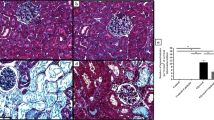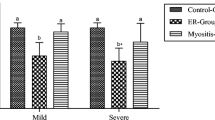Abstract
The present study was carried out to evaluate the role of oxidative stress in the pathophysiologic process of acute renal failure associated with exertional rhabdomyolysis (ER) in Egyptian horses. ER was tentatively diagnosed in 31 Baladi horses based on case history, physical examination findings and confirmed by elevation of plasma creatine kinase (CK) and urine myoglobin concentrations. According to severity of the condition, the diseased horses were categorized into two main groups; the first group included 18 horses with minimal clinical signs and plasma CK <60 000 IU/L; whereas, the second group included 13 horses with overt clinical signs and plasma CK >100 000 IU/L). It was found that plasma creatol (CTL) was positively correlated (p < 0.01) with plasma malondialdehyde (MDA) (r = 0.775), nitric oxide (NO) (r = 0.768), methyguanididne (MG) (r = 0.995), CK (r = 0.768), urine glucose (r = 0.778), urine protein (r = 0.767), renal failure index (RFI) (r = 0.814) and urine sodium (r = 0.799) and negatively correlated (p < 0.01) with total antioxidant capacity (TAC) (r = −0.795), superoxide dismutase (SOD) (r = −0.815), glutathione peroxidase (GSH-Px) (r = −0.675), Vitamin C (r = −0.830), urine creatinine (r = −0.800), urine/plasma creatinine ratio (r = −0.827) and urine/plasma urea ratio (r = −0.807). The correlation between these biochemical variables might suggest a possible role of oxidative stress in renal injury associated with severe rhabdomyolysis in horses. It is suggested that exaggeration of oxidative stress associated with increased muscle membrane leakage plays a key role in acute kidney injury in Baladi horses with severe rhabdomyolysis.
Similar content being viewed by others
References
Avellini L, Silvestrelli M, Gaiti A (1995) Training-induced modifications in some biochemical defences against free radicals in equine erythrocytes. Vet Res Commun 19:179–184
Balogh N, Gaál T, Ribiczeyné P, Petri A (2001) Biochemical and antioxidant changes in plasma and erythrocytes of pentathlon horses before and after exercise. Vet Clin Pathol 30:214–218
Carlström B (1932) Über die Ätiologie und Pathogenese der Kreuzlähmung des Pferdes (Hämoglobinämia paralytica) Skan. Arch Physiol 63:164–169
DeWitt J, Lamprech E, Williams C (2007) Nitric oxide concentration in plasma and synovial fluid of intensely exercising horses. Equine Sci Soc Proc 20:64–65
El-Deeb W, El-Bahr S (2010) Investigation of selected biochemical indicators of Equine Rhabdomyolysis in Arabian horses: pro-inflammatory cytokines and oxidative stress markers. Vet Res Commun 34:677–689
Gissel H (2006) The role of Ca2+ in muscle cell damage. Ann NY Acad Sci 1066:166–180
Grossman B, Brobst D, Kramer J, Bayly W, Reed S (1982) Urinary indices for differentiation of prerenal azotemia and renal azotemia in horses. J Am Vet Med Assoc 180:284–288
Hargreaves B, Kronfeld D, Waldron J, Lopes M, Gay L, Saker K, Cooper W, Sklan D, Harris P (2002) Antioxidant status of horses during two 80-km endurance races. J Nutr 132:1781–1783
Hutyra F, Marek J (1926) Diseases of the blood and blood-producing organs: paralytic hemoglobinemia. In: Mohler JR, Eichhorn A (eds) Special pathology and therapeutics of the diseases of domestic animals, first ed., Diseases of the urinary organs, blood and blood producing organs, spleen, metabolism, nervous system, organs of locomotion, and skin, vol III. Alexander Eger, Chicago, pp 146–162
Ienaga K, Nakamura K, Fujisawa T, Fukunaga Y (2007) Urinary excretion of creatol, an in vivo biomarker of hydroxyl radical, in patients with chronic renal failure. Ren Fail 29:279–283
Kinnunen S, Atalay M, Hyyppä S, Lehmuskero A, Hänninen O, Oksala N (2005) Effects of prolonged exercise on oxidative stress and antioxidant defense in endurance horse. JSSM 4:415–421
Koracevic D, Koracevic G, Djordjevic V, Andrejevic S, Cosic V (2001) Method for the measurement of antioxidant activity in human fluids. J Clin Pathol 54:356–361
Matsuki N, Tamura S, Ono K, Watari T, Goitsuka R, Yamanobe A, Hiraga A, Kubo K, Takagi S, Hasegawa A (1991) Exercise-induced phospholipids degradation in the equine skeletal muscle and erythrocytes. J Vet Med Sci 53:1001–1007
Mills P, Smith N, Casas I, Harris P, Harris R, David J (1996) Effects of exercise intensity and environmental stress on indices of oxidative stress and iron homeostasis during exercise in the horse. Eur J Appl Physiol 74:60–66
Nakamura K, Ienaga K, Nakano K, Nakai M, Nakamura Y, Hasegawa G, Sawada M, Kondo M, Mori H, Kanatsuna T (1994) Creatol, a creatinine metabolite, as a useful determinant of renal function. Nephron 66:140–146
Ono K, Inui K, Hasegawa T, Matsuki N, Watanabe H, Takagi S, Hasegawa A, Tomoda I (1990) The changes of antioxidative enzyme activities in equine erythrocytes following exercise. Nippon Juigaku Zasshi 52:759–765
Plotnikov EY, Chupyrkina AA, Pevzner IB, Isaev NK, Zorov DB (2009) Myoglobin causes oxidative stress, increase of NO production and dysfunction of kidney’s mitochondria. Biochim Biophys Acta 1792:796–803
Prior RL, Cao G (1999) In vivo total antioxidant capacity: comparison of different analytical methods. Free Radic Biol Med 27:1173–1181
Sjodin B, Westing Y, Apple F (1990) Biochemical mechanisms for oxygen free radical formation during exercise. Sports Med 10:236–254
Sprayberry K, Madigan J, LeCouteur R, Valentine B (1998) Renal failure, laminitis, and colitis following severe rhabdomyolysis in a draft horse-cross with polysaccharide storage myopathy. Can Vet J 39:500–503
Stadhouders AM (1981) Cellular calcium homeostasis. mitochondria and muscle cell disease. In: Busch HFM, Jennekens FG, Scholte HR (eds) Mitochondria and muscular diseases., pp 77–88
Valentine B, Divers T, Lavoie J (1996) Severe equine polysaccharide storage myopathy in draft horses: clinical signs and response to dietary therapy. Proceedings Am Assoc Equine Pract 42:294–295
Vanholder R, Sever MS, Erek E, Lameire N (2000) Rhabdomyolysis. J Am Soc Nephrol 11:1553–1561
Williams C, Kronfeld D, Hess T, Saker K, Waldron J, Crandell K, Hoffman M, Harris P (2004) Antioxidant supplementation and subsequent oxidative stress of horses during an 80-km endurance race. J Anim Sci 82:588–594
Conflict of interest statement
The author of this paper has no financial or personal relationship with other people or organizations that could appropriately influence or bias the content of the paper.
Author information
Authors and Affiliations
Corresponding author
Rights and permissions
About this article
Cite this article
El-Ashker, M.R. Acute kidney injury mediated by oxidative stress in Egyptian horses with exertional rhabdomyolysis. Vet Res Commun 35, 311–320 (2011). https://doi.org/10.1007/s11259-011-9475-9
Accepted:
Published:
Issue Date:
DOI: https://doi.org/10.1007/s11259-011-9475-9




